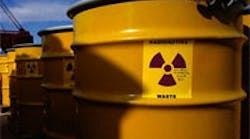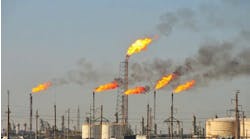"Ask the Experts" is moderated by Béla Lipták, editor of the Instrument Engineer's Handbook (IEH). He is recruiting co-authors who will bring fresh blood and increase the globalized nature of his team of authors for the 5th edition of the IEH. He welcomes offers from qualified colleagues to prepare new or update existing contributions. Contact him at [email protected].
Q: We have remote-handled, (relatively high activity), 35% solids, radioactive sludges in Oak Ridge National Laboratory's Melton Valley storage tanks from which we're going to extract (at 2%-11% solids concentration in the slurry), dilute to <5% solids in a hold tank, transfer to the process facility and solidify/dispose as radioactive waste at a pre-approved federal disposal site.
This sludge is potentially stratified and definitely heterogeneous in each tank. Its supernatant phase varies both across the tanks and across the extraction process. We're to measure flow, percentage solids and density in real time, having considered Coriolis and other meters. Also:
- Bulk density of the sludge is 1.4-1.6
- Density of the dry solids is 2.75-3 g/cc
- Density of the supernatant is 1.05-1.1 g/cc
- pH of the supernatant is 9-12 (most likely 11-12)
At the risk of sounding flippant, I believe the answer lies somewhere between "You can't get there from here," and "Other than that, Mrs. Lincoln, how was the play?" We're not optimistic regarding on-line techniques. We can design the extraction system with a recirculation loop (both for the monitoring instrumentation and maintaining particles in suspension), but that doesn't get us to the point of measuring percentage of suspended solids in a variable-density solution. Some level of transmissivity measurement might be possible, but this sludge has all the opacity of chocolate milk (once mobilized).
In the near term, we're looking to put a mock-up of the tanks and extraction system in place (non-radioactive) here, and will be in a position to test candidate measurement systems. So, we may end up with something contrived, but that also works. Any thoughts or suggestions on hardware would be appreciated.
Christopher Shannon
[email protected]
A: For mass flow detection, both Coriolis and ultrasonic flowmeters can be considered if the volumetric flow reading of the ultrasonic meter is multiplied with sludge density. If the pipe is large, ultrasonic, sonar and fiberoptic designs are good candidates. Sonar flow detection is used in downhole offshore oil and gas production.
A sonar meter has an array of sensors clamped onto the pipe, and detects the speed of eddies as they pass these sensors. All-fiberoptic flowmeters also have been deployed in applications for both flow and phase fraction measurement.
As to continuously detecting percentage of solids in applications where you know the density of the solids and of the supernatant, I usually calculate percent of solids by: % = (SP1-SP3)/(SP2-SP3), where SP1 is the specific gravity of the sludge, SP2 is the dry solids, and SP3 is the supernatant. Therefore, you need three density measurements and the corresponding sampling systems.
For the details of automatic sludge sampling designs, see Chapter 8.2 in Volume 1 of the 4th edition of my handbook.
You should keep in mind that measurements that work in a mock-up might not work when you apply them to the full-scale process. Also, I will have an article (probably the Sepember issue) on the state of the art of nuclear power plant waste disposal, which you might be interested in reading.
Béla Lipták
A: Have you had a look at the sonic meters from Cidra? They are being used in the oil sands to measure the four-phase slurry flows in 27-in. lines from the mine face to the extraction plants and then again in tailings. They are non-intrusive, and should do a good part of the job. I have copied John Viega of Cidra on this note, so he can respond directly as well.
Also, a company called Caltron, (part of Emerson now, I think) had a non-invasive capacitance probe installed between a pair of flanges that could provide water content.
Ian Verhappen
[email protected]
A: When I was at Oak Ridge, I developed a probe that measured density and temperature along the probe. This probe was based on ultrasonics; it used the torsional mode. The probe was non-circular; we used a flattened probe about the size of a thermocouple probe used in reactors. Any non-circular probe would work. I switched between extensional mode to measure temperature and torsional mode to measure the density of the fluid surrounding the probe. There is an equation describing the velocity of propagation that includes density of the fluid surrounding the probe. It sounds to me like this probe might have application in this project.
By the way, the probe was originally developed after the Three Mile Island accident to measure coolant level in a nuclear reactor. In that measurement, one can't measure coolant level because the coolant is always at the top. Where coolant is lost in a reactor is at the hot spot, i.e., the core. You would have, from the bottom of the reactor vessel, water, void fraction and then water. This probe was designed for that environment, and would have taken the place of one of the thermocouples in the reactor.
George N. Miller, P.E.
[email protected]
Q: Could you suggest to me some MPC (multivariable predictive control) literature (books, articles, white papers, lectures, etc.) that I can study in order to fully understand how to design, implement and maintain an MPC project?
I have found some sources of information, but they are not practical to carry out an application in the real world. That is why I am looking for some literature that could be classified as "MPC for Mortals," that is, not for scientists with PhDs, etc., but something understandable by the guys that implement process control and operate the plants.
Marcos Francisco Moreno Molina
[email protected]
A: The 3rd Volume of the Instrument Engineers' Handbook (IEH) discusses modeling and model-based control in chapters 5.1 and 5.2. This volume was published in 2000, and since that date much experience has been gained through a wide range of industrial applications. As the new editions of the IEH are published once in a decade, the 4th edition will be published in 2011 and will contain much more information than did the 3rd edition.
As to the emphasis on theory versus engineering application, you will find that all three volumes are written for the practicing engineers and not for academia, so you might find the treatment of MPC suited for your needs.
Béla Lipták
A: I wrote Chapter 13 on "Advanced Control" in the ISA book, A Guide to the Automation Body of Knowledge, and Chapter 4 on "Model Predictive Control" in the ISA book, New Directions in Bioprocess Modeling and Control. I tried to make the discussions of model predictive control as simple as possible.
Greg McMillan
[email protected]
A: First of all, make sure that MPC is a technology that is suitable for your needs, because MPC can be very elusive in its application.
Secondly, there's no magic: MPC can't do anything about stabilizing a plant with oscillatory behavior, especially when it's caused by defective field instrumentation.
There are several vendors who can provide you with the the technology. The difference in the quality of their advice will come from the experience of their in-house people.
If you've done your homework with the regulatory loops, the best book I ever found on the subject is Predictive Control with Constraints by Jan Maciejowski. It needs Matlab and the MPC module programs available off the book's website. Another is Model Predictive Control by Eduardo Fernandez Camacho and Carlos Bordons Alba. It also needs the Matlab program available off the book's website.
Mathematics, yes. No short cuts, no free lunch.
If you're only interested in the 30,000-ft view, then there are multiple websites (and millions of papers) available on the Internet with a description that may suit your current needs. Hope this helps.
Sigifredo NINO
[email protected]
A: I think it's probably too much to expect that one can come up to speed on the practice of MPC solely from reading and study, but I agree it can be difficult getting practical information. Here are some suggestions.
- The website www.apc-network.com has many articles on MPC and also on other technologies such as real-time optimization, soft sensors, etc. Anyone can register at this website.
- I think the following books are worth a look: Process Control (McGraw Hill) by Thomas E. Marlin, which gives a nice introduction to MPC. Another book containing a readable introduction is Techniques of Model-Based Control by Coleman Brosilow and Babu Joseph (Prentice Hall).
- I also wrote a paper and gave the presentation at last year's ADCHEM conference. The goal was to cover the current practice of MPC, associated challenges, and show where improvements are needed.
Mark L. Darby, PhD, PE
[email protected]



